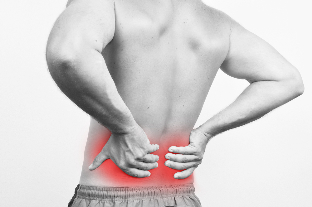Almost everyone in the course of his life, at least one long episode of back pain, and one-third of adults these unpleasant sensations are repeated regularly. The urgency of the problem as can be seen from at least the fact that for the treatment of back pain every year, spend three times more money than the therapy for cancer patients.
The duration of the episode of pain is usually around 2 weeks, but in many patients, residual symptoms persist for months or longer. Havepart of these patients are diagnosed herniated discs, spinal canal disease, diseases of the kidneys, ovaries and other internal organs, and sometimes malignant tumors, or their metastases.
In our article, we briefly describe the main reasons for pain in the back, and their distinctive characteristics that help people to understand that with his health problems, and it is time to consult with a doctor.
The possible reasons for pain in the back:
- lesions of the spine, its ligaments and muscles;
- the denial of roots and other diseases of the spinal cord;
- diseases of the internal organs;
- connective tissue diseases;
- depression and psychogenic disorders.
Been proven that back pain often occur in the low physical activity, obesity, Smoking, heavy physical work, stay in awkward positions, prolonged action of vibration, and sharp turns of the torso.
Diseases of the spine, its ligaments and joints

Most people with complaints of back pain they occur because of lesions of the intervertebral discs, joints between the processes, as well as themselves the bone of the vertebral body. With age the discs between the vertebrae lose water, reducing their thickness. As a result of the increased mobility of individual spinal segments, which irritate the pain receptors of the intervertebral joints. It should be noted that often even in people with pronounced age changes of the spine pain in the back is not. Often a herniated disc in combination with pain randomly.
In recent years, a growing importance in the development of constant pain in the back are given t.n. syndrome of the joints with "small person" — a private form of osteoarthritis affecting the articular apparatus of the spine.
The pain in this syndrome may be unilateral, bilateral, localized in the vicinity of the spine, most often in the lumbar region extends into the thigh. Pain often occurs in the morning, but in the course of the day and re-increased after load for the evening. For the first time appears usually after a sharp, uncomfortable or torso. The pain is worse in standing and extension of the arms is decreased in the sitting position or lying down, with light bending, the use of support. Syndrome of the joints with "small person" often recurs.
Often cause pain in lesions of the spine the following condition:
- spondylolisthesis – displacement of vertebrae in relation to each other;
- the spinal stenosis;
- ankylosing spondylitis (Bechterew's disease);
- osteoporosis fractures of the vertebral bodies (often in old persons, especially in women);
- a large disc herniation (more than 5 mm);
- diseases of the cervical spine.
The lack of physical activity in the course of the working day is characteristic of work in the office. Lack of movement, long stay in an awkward position and provoke excess stress on the joints and cause pain, discomfort and gradual destruction of the cartilage. Therefore, office workers are advised to regularly do exercises, and they need funds in protecting and regenerating cartilage.
More rare, but dangerous causes of pain syndrome is a tumor, most often it is the metastases in the spine. The risk increases if the patient has any cancer (often lung cancer, breast cancer and prostate cancer), weight loss, fever, duration of complaints more than a month ago, at the age of 50 years. Metastases most frequently affect the thoracic spine.
The other reason for back pain associated with cancer is myeloma. Rarely, but there are benign and primary malignant tumor of the spine, for example, a benign tumor produced from bone tissue, ewing sarcoma is.
Ankylosing spondylitis should be suspected in a young patient age, morning stiffness of the spine and large joints, improving upon heating. The pain often appears in the gluteal region. Is characterized by its gain of the night, so sick in the morning not able to sleep due to discomfort.
Back pain can occur for other symptoms, which are observed in the following diseases:
- psoriatic arthritis;
- rheumatic diseases;
- juvenile rheumatoid arthritis;
- Crohn's disease, Whipple, ulcerative colitis;
- shigellosis, salmonellosis.
An important component of a comprehensive treatment is the administration of medications, the effectiveness of which is in the direction of preserving and improving the condition of joints and cartilage. Injection provides maximum bioavailability and speed of action of the drug, which helps to stop the progression of the destruction of the cartilage, reduces inflammation and stimulates the synthesis of hyaluronic acid. Due to the fast start of the application there is no need for long courses of the drug a total of 20 injections 2 times a year. Supplement they the treatment of pain in the back allows to reduce the dose and duration of use of Nsaids.
Osteomyelitis of the spine or spondylitis should be assumed for prolonged fever, intravenous medications or drug use, previous infectious disease or trauma, administration of immunosuppressants. Inflammatory diseases of the spine can have a specific nature, with the origin of syphilis, tuberculosis.
Defined by t.n. indicators of serious problems requiring a thorough examination of the patient:
- suddenly, for the first time, appeared pain;
- very strong pain;
- no correlation of pain from the position of the body;
- the pain is stronger at night than during the day;
- patient age younger than 20 and older than 55 years;
- a recent back injury;
- the probability of infection (inflammation of the urogenital tract, taking immunosuppressive agents, acquired immunodeficiency syndrome);
- moved cancer;
- unexplained weight loss and fever;
- weakness;
- incontinence of urine or faeces;
- holding distortion;
- progressive neurological disorders.
Lose muscle

Lose back muscles can be secondary: in diseases of the spine, the muscles tense, and the creation of a "protective system" that holds our vertebral column, but from the constant tension and spasm are the cause of the pain. Often a muscle spasm occurs at the beginning, for example, during the long stay in awkward positions or increased anxiety. This pain syndrome has a relatively benign course and responds well to medical therapy.
Some systemic diseases of the muscles is also present with pain in the back. They include:
- of rheumatic polymyalgia;
- fibromyalgia.
Fibromyalgia is a fairly common disease, often occur in middle-aged women. It is characterized by diffuse pain in the muscles of the body, weakness, sleep disturbances, changes in skin sensation, anxiety, unstable chair.
Pathology of the spinal cord and its roots
Compression of the spinal roots appear through the holes between the vertebrae, is a more rare reason for pain in every 10-th patient. However, this pain syndrome stronger and longer, and the treatment lasts about 2 months.
Compression (compression) of the root of the cause:
- hernia of the intervertebral discs;
- hypertrophy of the yellow ligament;
- the growth of bones;
- narrowing of the spinal canal (eg, due to injury).
The image of the destruction of the roots (radiculopathy): a sharp "shooting" pain, disturbance of sensation in the area of innervation of the spine, decreased reflexes, weakness of the corresponding muscles. If the compression of the spine has been proven by modern research methods and drug treatment is inefficient, sometimes resort to surgery.
Diseases of the internal organs
Back pain occurs not only in diseases of the spine or spinal cord, but also accompanied by many diseases of the internal organs:
b- heart disease (myocardial infarction, stable and unstable angina, infective endocarditis, aortic aneurysm);
- lung disease (pulmonary embolism, pneumothorax, pleurisy);
- pathology of the esophagus and the stomach (peptic ulcer, esophageal spasm, esophagitis);
- inflammatory processes in the kidney, liver, pancreas, gall bladder.
Usually distinguish these diseases allow for two things:
- a sudden and very intense pain in the back;
- signs of damage to the relevant authorities (shortness of breath, rales in the lungs, pain on palpation of the abdomen, and so on).
For back pain, especially that arising suddenly and is not accompanied with the signs of diseases of the spine, is not always necessary to register an electrocardiogram to exclude acute myocardial infarction. Especially this atypical localization of pain in ischemic heart diseases typical for the elderly.
Psychogenic disorders
The transition of the pain in the chronic form contribute to social and behavior factors:
- financial difficulties;
- emotional stress;
- confidence in the inevitability of pain, because of its obvious connection with the day-to-day operations;
- thoughts about a possible serious illness and disability;
- depression;
- depending on the other people;
- the strategy of avoiding the disease, in which the patient does not take any action for the diagnosis and treatment of your condition.
What doctor to address
So the causes of back pain are different. Often they are associated with diseases of the spine and spinal cord, when it will occur, you will need to consult with a neurologist. Also, you may need to consult other specialists: neurosurgeon, oncologist, gastroenterologist, cardiologist, surgeon, and psychologist. To choose the right specialist, you can first contact the therapist after the initial examination to determine a temporary diagnosis.





































